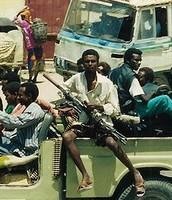It has been a whirlwind two weeks for one of the world's most chaotic countries. Since the last week of January, Somalia has seen the collapse of the U.S.- and U.N.-backed Transitional Federal Government and major advances by Islamic insurgents. But the TFG's rout morphed into a modest triumph when the body elected a new, moderate president-in-exile, amid the promise of peace mediation by Islamic clerics. The catalyst for all of these moves was the seeming final withdrawal of Ethiopian troops following two years of bloody occupation. In recent months the Ethiopians had consolidated their positions in Mogadishu and the parliamentary seat of Baidoa, leaving a shifting patchwork of Islamic groups in charge of most of the rest of the country. The Ethiopians departed Mogadishu on Jan. 15, and within hours, Islamic militants were setting up shop in long-vacant police stations in the embattled city.

Ugandan tank, Presidential Palace, Mogadishu, November 2007 (David Axe).
It was the same story in Baidoa, when on Jan. 26 the last truckload of Ethiopian soldiers rolled out of the city. Panicked parliamentarians bartered for safe passage out of Somalia in cars and aircraft as militants moved in and captured the city "without a fight," according to Moqtar Abu Mansoor, spokesman for al-Shabab, the main, hardline Islamic group.

